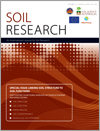Ver ítem
- xmlui.general.dspace_homeCentros Regionales y EEAsCentro Regional Tucumán - Santiago del EsteroEEA FamailláArtículos científicosxmlui.ArtifactBrowser.ItemViewer.trail
- Inicio
- Centros Regionales y EEAs
- Centro Regional Tucumán - Santiago del Estero
- EEA Famaillá
- Artículos científicos
- Ver ítem
Soil properties of sugarcane fields controlling triazine leaching potential.
Resumen
Atrazine and ametryn are pre- and post-emergence herbicides widely used in sugarcane fields. Both herbicides are characterized by their moderate to high mobility in soil and are regarded as a threat to hydrologic systems. Physical and chemical soil properties are highlighted as one of the factors governing the fate of pesticides in hydrologic systems. The aim of our study was to estimate the leaching potential of atrazine and ametryn in soils of the
[ver mas...]
Atrazine and ametryn are pre- and post-emergence herbicides widely used in sugarcane fields. Both herbicides are characterized by their moderate to high mobility in soil and are regarded as a threat to hydrologic systems. Physical and chemical soil properties are highlighted as one of the factors governing the fate of pesticides in hydrologic systems. The aim of our study was to estimate the leaching potential of atrazine and ametryn in soils of the saline alluvial plain of Tucumán cultivated with sugarcane crop. Miscible displacement experiments were carried out in triplicate using undisturbed topsoil cores from four farm fields. Field 1 was in plant, fields 2 and 3 were in second ratoon, and field 4 was in third ratoon. Experimental breakthrough curves were fitted to the convection-dispersion equation; results showed that hydraulic transport was in equilibrium conditions, meaning that all the soil water was involved in solute convective transport. Atrazine had asymmetric breakthrough curves, revealing chemical non-equilibrium conditions, with at least two sorption-desorption sites participating in the process. In contrast, ametryn concentrations in leached samples were low and inconsistent; therefore, no breakthrough curves could be described. Total recoveries reached 10% and 2% for leached atrazine and ametryn, respectively, of the total applied. For an estimated annual recharge of 100 mm, these leached amounts would exceed the international reference values for drinking water.
[Cerrar]

Fuente
Soil Research Published online: 21 August 2019
Fecha
2019-08-21
Editorial
CSIRO PUBLISHING
ISSN
1838-675X
1838-6768
1838-6768
Formato
pdf
Tipo de documento
artículo
Palabras Claves
Derechos de acceso
Restringido
 Excepto donde se diga explicitamente, este item se publica bajo la siguiente descripción: Creative Commons Attribution-NonCommercial-ShareAlike 2.5 Unported (CC BY-NC-SA 2.5)
Excepto donde se diga explicitamente, este item se publica bajo la siguiente descripción: Creative Commons Attribution-NonCommercial-ShareAlike 2.5 Unported (CC BY-NC-SA 2.5)

